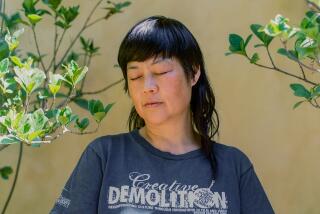Chasing the shadows
- Share via
On Nov. 9, 2004, historian Iris Chang was found dead on a rural California road just south of Los Gatos. The official cause of death was a self-inflicted gunshot. Chang, 36, who had suffered from bipolar disorder, left behind a husband and an autistic son. She’d gained international attention for her 1997 book detailing the 1937 massacre in China by the invading Japanese army. “The Rape of Nanking” sold half a million copies and caused Japanese advertisers to withdraw from Newsweek when the magazine ran an excerpt. It spawned nervous communiques between the U.S. Embassy in Tokyo and the State Department, as well as a confrontational TV exchange between Chang and the Japanese ambassador.
In “Finding Iris Chang,” Paula Kamen tries to come to terms with her friend’s life and death. The book is more an investigation than a meditation, expanded from a remembrance Kamen wrote for Salon.com a few weeks after Chang’s suicide. Kamen doesn’t entirely pinpoint the driven woman who scoured the National Archives for documents or the ambitious journalist who charmed many people despite her blunt words and outsized ambition. This may have something to do with the fact that Chang’s editor refused to be interviewed for the book or that Chang’s archives are sealed until 2015.
Nevertheless, Kamen still has material to draw from. There are Chang’s letters, including one claiming that California is inferior to the East Coast as a reading environment; a childhood jotting from “Secret Spys [sic] Iris’s Notebook” (“When taking notes, write in code form”); and an unused interview transcript in which Chang pounded her fists over an infamous Newsweek article that claimed a woman over age 40 was “more likely to be killed by a terrorist” than get married.
Chang had a fiery temperament, yet many of her friends -- at least the ones Kamen talked with -- didn’t dwell in detail upon her mental instability, preferring to memorialize her with quiet qualifiers. We are told that Chang was “positive and energetic” by a close friend in her writing group. Another describes Chang as an “oscillator,” someone “with a palpable sense of urgency to achieve.” Her husband, Brett Douglas, gives examples of what he calls her “attention surplus disorder.” Perhaps most remarkable, Douglas met a 36-year-old woman named Iris just weeks after Chang’s death. (It’s also worth observing that three years after Chang’s death, her official website still includes her contact information.)
We also learn that Chang was picky about the food she ordered at restaurants, that she warmed up to political incorrectness by wearing a fur coat, that she suffered from insomnia when writing her books and that she was fond of talking for long hours on the phone.
But what does this add up to? Kamen sticks to a strict series of questions about Chang, but this hinders her from ironing out some rumpled linen. A more personal journey into her friend’s life might have tightened a few baggy wrinkles. Midway through the book, Kamen confesses to a friend of Chang’s that writing the book is “not as depressing as I thought.” He responds, “That’s because she has become a character to you. She is a subject now, something you’re writing about.”
The great irony is that even in death, Chang’s looming shadow dwarfs Kamen’s effort to be fully honest about how much Chang meant to her. That’s a pity because, for all the vivid details about the historian, their friendship is the more interesting and less pursued narrative.
There’s a moment in Chicago when Chang spends hours grilling a depressed Kamen. Kamen doesn’t want to talk about her emotional state, but Chang insists. That night, Kamen writes about Chang in her journal: “No spiritual awareness. She had no idea of experiences other than her own.” But Kamen doesn’t explain why she tolerated these “quirks” or why she didn’t tell Chang to buzz off.
This reticence is curious, because Kamen had no problem detailing her chronic headache pain in her previous book, “All in My Head.” And in some ways, it’s a disservice to Chang. Shouldn’t we get a better sense of why Chang’s magnetism caused many of her friends to acquiesce so readily?
Instead of pursuing this angle, Kamen loses her trajectory by tossing in some armchair psychology. We learn of the pressure on Asian immigrants to be the “model minority” and that Chang “fit a profile as being at higher risk for a mood disorder as a creative type,” with Kamen citing Kay Redfield Jamison’s “Night Falls Fast.” But the passage she quotes refers to such artists as the poets Percy Bysshe Shelley and Gerard Manley Hopkins, not historians. Nor can the quixotic suggestion that Chang fit the cultural role of “ ‘crazy’ person as brave crusader” be given credence because Kamen’s comparison involves the cinematic turkey “National Treasure.”
From such generalities, the author concludes, “I myself was finally connecting the dots about Iris.”
These unfortunate asides are somewhat redeemed by an eleventh-hour segue into the reluctance of some Asian Americans to discuss the topic of suicide. Kamen notes that Asian American women ages 15 to 34 are twice as likely to commit suicide as their white counterparts. Chang’s suicide is a rallying cry to discuss this issue.
But Kamen’s failure to flesh out her own complex feelings suggests that, contrary to her assertions in the afterword, Chang still casts an imposing adumbration.
--
EXCERPT:
To read the introduction, go to
latimes.com /irischang.
More to Read
Sign up for our Book Club newsletter
Get the latest news, events and more from the Los Angeles Times Book Club, and help us get L.A. reading and talking.
You may occasionally receive promotional content from the Los Angeles Times.






